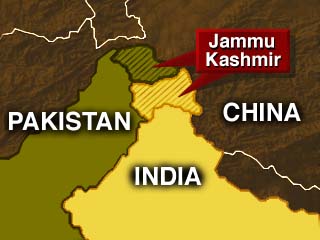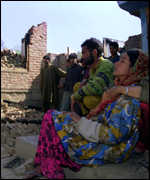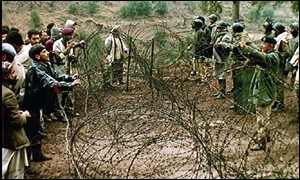
Historians have traced the history of Kashmir to the 7th century. Some have written that in the 2nd century A.D. Kashmir was annexed by Emperor Kunishka who made it part of the Kushan Empire (which later became part of ancient China).
It is known that during its long history Kashmir existed as an independent sovereign state for good 10 centuries and flourished as a model state in the region. The most glorious and talked about was the period referred to by the Kashmiris as the 'golden era' of Sultan Zain-al-Abadin (1420-1470), commonly known as the 'Budshah'.
Kashmir's long history of independence came to an end when in 1586 the Mughal's conquered it but the real tragedy began when in 1752 neighboring Afghan rulers finally succeeded in taking over. They established a ruthless reign, which lasted for over two generations. The Afghani occupation was followed in 1819 by an equally brutal and oppressive rule by the Sikh Maharaja of Punjab which in turn was overturned by the British in 1846.
The state of Jammu -Kashmir (including Ladakh, Baltistan and Gilgit territories) was handed over to a Dogra prince of Jammu by the British under the terms the notoriously infamous
'Treaty of Amritsar' in March 1846. The Dogra dynasty lasted until 1947.Despite occasional resistance against the Dogra exploitations, they ruled J&K with an iron fist but as a sovereign independent princely state.

In July 1931, a spontaneous but popular rebellion took place, which became the milestone of the Kashmiri freedom movement.
(It gave rise to Quit Kashmir movement even before the idea of separate Islamic Pakistan was formalised by Indian Muslims).In August 1947, when the British Raj came to an end and the paramountency relinquished, two separate countries, namely India and Pakistan, were created as nation states. The semi-autonomous states such as Kashmir (not under direct British rule) became sovereign independent states by default with options to remain independent or accede to one or the other of the newly created dominions. Kashmir's misfortunes were not to end here.
India and Pakistan both had their reasons to seek accession of Jammu-Kashmir to their country. Their designs to win the race through political intrigue, deceit and naked aggression (to annex Kashmir) brought the conflict and their expansionist territorial ambitions out in the open.

In the military conflict that followed Kashmir was divided into two parts, two third of which (63%) went under Indian occupation and the rest (37%) under Pakistan. Pakistan justified its move by claiming that majority of Kashmir's Muslims wanted to accede with newly created Islamic Pakistan. India's justification of her invasion on 27th October 1947 was based on the fact that Indian leaders were able to persuade the autocratic ruler of Kashmir to sign a temporary 'Instrument of Accession 'in her favour just a day earlier. However, the authenticity of the date on that 'treaty' remains subject of a fierce dispute even today
Maharaja Hari Singh was faced with a popular rebellion against his continued inhumane rule and draconian laws from his subjects. In order to save his crown he is said to have signed this temporary "Accession Treaty" drawn up by India which gave her powers to enter Kashmir. The Governor General of India, Lord Mountbatten, however, made it clear that the treaty was subject to a later ratification by the people of J&K which never took place. As the Maharaja did not seek to test the will or satisfy the wishes of his subjects it gave rise to further disquiet by the Kashmiri population.

The 1947 revolt against the Maharaja, lead by members of Muslim Conference, which was formed as a result of the 1931 rebellion resulted in liberation of a third of the country but for Kashmiris that small victory was short lived. Muslim Conference had been split into two factions but on 4th October 1947 a provisional government known as Republic of Azad-Kashmir was declared as a people's representative body deposing the Maharaja off his throne. That provisional administration was quickly replaced by another regime aided by Pakistan, which eventually lost all self-assumed powers to 'friendly' Pakistan. (Ever since then it has remained a subservient authority under Pakistan's control, despite 'electing' its own Prime Minister and President).
On 1st January 1948, India took the issue to the United Nations (referred to as India and Pakistan Question). The UN Security Council took action and in order to restore peace imposing a
cease-fire between the Indian and Pakistani forces fighting in Kashmir. It was able to persuade the two warring nations to agree to a complete withdrawal of their troops from J&K on paper. A commission was setup and several resolutions were passed in the following years but no outcome satisfying Kashmiri aspirations was arrived at. Both India and Pakistan fought for their respective interests at the UN but Kashmiri case was not pleaded properly due to lack of representations. United Nations Military Observers were sent in the area who have remained there for over half a century. Both Indian and Pakistani leaders pledged to the world to withdraw from Kashmir and to allow the people of J&K to exercise their right of self-determination but subsequently both reneged to take steps to fulfill those pledges.The cease-fire demarcation divided Jammu-kashmir into two parts. Families and communities were split in the middle. During the process of that bloody partition tens of thousands were massacred in the Jammu region. Many families continue to endure the trauma of that everlasting nightmare even today.

The unprecedented human tragedy, which has caused immense suffering in the area, continues to unfold even today. In 1947/48 young Muslim men were killed off in the Jammu regions and their girls taken by non-Muslims and non-Muslim girls forced to convert and marry Muslim men only to be given the opportunity later to go back to their original religion but leaving the children behind.
As India continued to dig deep in order to perpetuate her hold on Kashmir it lost a large Kashmiri territory to China in a war in 1962. Over the years, while the UN became an instrument in the international power game the world community lost interest in the
plight of the Kashmiris. India and Pakistan went to war again in 1965 with a result that the question of Kashmiri self-determination was pushed further down the agenda. Both India and Pakistan continue to battle for hegemony in the region. Half a century on - with United Nations membership of free countries almost doubled - the Kashmiris are still waiting to exercise their alienable right to self-determination.
In 1997/98 Kashmir became the battleground for the largest military conflict in the region. Indian armed forces on active duty are exceeded over half a million in numbers. Indian troops are alleged to have killed over 60,000 Kashmiris so far. Thousands of young Kashmiri men women and children are languishing in Indian prisons and many have disappeared. Hundreds have been maimed and disfigured in torture cells. Billions worth of properties have been looted or destroyed. Kashmir's historically peaceful and docile people continue to pay a heavy price for demanding to exercise their right to self-rule. While Pakistan now claims to support Kashmiri peoples right to self-determination India continues to defy all international laws and obligations. Both India and Pakistan have now become nuclear powers when Kashmir has become a nuclear
flashpoint in the region.
Over the last 50 years the Kashmiri struggle for re-unification and independence has continued in different phases and manners but it has now become a nationalist movement and is gaining strength on both sides of the divide. While both India and Pakistan continue to blame each other instead of offering the Kashmiris their right to self-determination, world pressure has begun to mount to seek a peaceful resolution. Kashmir's peaceful struggle was transformed into armed resistance when in 1984 India illegally hanged a Kashmiri revolutionary leader
Maqbool Butt.

In 1988, JKLF came into prominence when it took the center stage of Kashmiri politics by storm. Since than it has become the biggest challenge for the occupation forces of Jammu-Kashmir. Thus the struggle continues ...